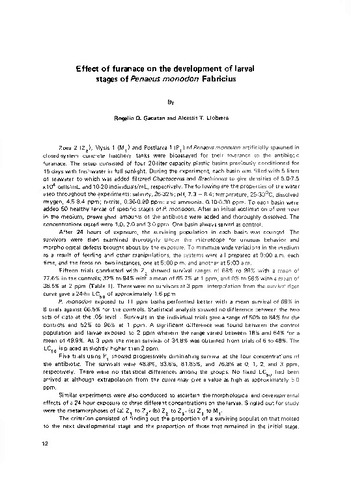Laboratory manipulation of Gracilariopsis bailinae Zhang et Xia (Gracilariales, Rhodophyta)
- Global styles
- MLA
- Vancouver
- Elsevier - Harvard
- APA
- Help

View/Open
Date
1997Page views
1,974ASFA keyword
Taxonomic term
Metadata
Show full item recordCited times in Scopus
Share
Abstract
Carpospore germination, carposporeling development and tetraspore formation were investigated in Gracilariopsis bailinae Zhang et Xia by manipulating photoperiod, photon flux density, temperature, salinity and nutrients. Laboratory-generated sporelings attained mean growth rate from 4.05 to 10.31% d-1 during the first week of incubation. Duncan s multiple range test (DMRT) showed that growth rates were significantly different (P < 0.05) between the treatment combinations and between weekly intervals. The optimal condition for growth of sporelings, irrespective of culture age, was attained at treatment combinations of 26°C, 11:13 (h. L:D) photoperiod, 100 µEm-2s-1 photon flux density (PFD), 25 µM NH4Cl: 2.5 µM K2HPO4 and 25ppt salinity followed by a treatment combination of 26°C, 11:13 (h. L:D) photoperiod, 100 µEm-2s-1 photon flux density (PFD), 50 µM NH4Cl: 5 µM K2HPO4 and 25 ppt salinity. For the first time in this species, tetraspore formation was induced in the laboratory. The tetrasporophyte produced many tetraspores in almost all branches of the thallus grown at 26°C, 11:13 (h. L:D) photoperiod, 100 µEm-2 s-1, 25 µM NH4Cl: 2.5 µM K2HPO4 and at 30 ppt salinity while those grown at lower light, higher nutrient level and higher salinity had fewer tetraspores. No tetraspores were formed at a higher temperature (30°C), longer photoperiod (13:11 h. L:D), and at 25 ppt salinity and the plants remained vegetative from 4 to 7 months. Logistic regression analysis showed that tetrasporangial induction was significantly affected by nutrients and salinity (P < 0.05).
Suggested Citation
Rabanal, S. F., Azanza, R., & Hurtado-Ponce, A. (1997). Laboratory manipulation of Gracilariopsis bailinae Zhang et Xia (Gracilariales, Rhodophyta). Botanica Marina , 40(1-6), 547-556. https://doi.org/10.1515/botm.1997.40.1-6.547
Type
ArticleISSN
0006-8055Collections
- Journal Articles [1247]
Related items
Showing items related by title, author, creator and subject.
-
Effect of furanace on the development of larval stages of Penaeus monodon Fabricius
Gacutan, Rogelio Q.; Llobrera, Alcestis T. (Aquaculture Department, Southeast Asian Fisheries Development Center, 1977)Zoea 2 (Z2), Mysis 1 (M1) and Postlarva 1 (P1) of P. monodon artificially spawned in closed-system concrete hatchery tanks were bioassayed for their tolerance to the antibiotic furanace. ... -
Effect of nitrite, ammonia, and temperature on P. monodon larvae
Catedral, Francis Fred; Gerochi, Dante D.; Quibuyen, Anacleto T.; Casalmir, Candelaria M. (Aquaculture Department, Southeast Asian Fisheries Development Center, 1977)P. monodon larvae were studied for the effects of temperature, ammonia, and nitrite on survival. Toxicity levels of nitrite were found to vary with larval stage. Larvae could tolerate ammonia up to about 10 ppm, with the ... -
Preliminary trials on the effects of weaning and larval diets on survival and growth of silver therapon (Leiopotherapon plumbeus) larvae
Aya, Frolan ; Nillasca, Vicar Stella N.; Garcia, Luis Maria
; Nillasca, Vicar Stella N.; Garcia, Luis Maria  (Aquaculture Department, Southeast Asian Fisheries Development Center, 2015)
Success in larval rearing of silver therapon can be achieved through early weaning of fish larvae from live food to artificial diet. Two experiments were carried out to investigate the effects of (a) weaning age (abrupt ...
(Aquaculture Department, Southeast Asian Fisheries Development Center, 2015)
Success in larval rearing of silver therapon can be achieved through early weaning of fish larvae from live food to artificial diet. Two experiments were carried out to investigate the effects of (a) weaning age (abrupt ...





